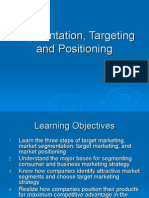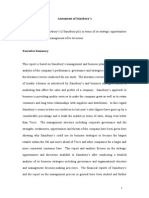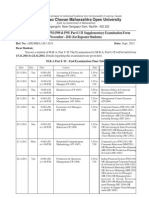Marketig Mix
Marketig Mix
Uploaded by
Abhishek TyagiCopyright:
Available Formats
Marketig Mix
Marketig Mix
Uploaded by
Abhishek TyagiCopyright
Available Formats
Share this document
Did you find this document useful?
Is this content inappropriate?
Copyright:
Available Formats
Marketig Mix
Marketig Mix
Uploaded by
Abhishek TyagiCopyright:
Available Formats
Pre Read: Marketing Mix
The term marketing mix was coined in an article written by Neil Borden called The Concept of the Marketing Mix. He started teaching the term after he learned about it from an associate, James Culliton, who in 1948 described the role of the marketing manager as a "mixer of ingredients"; The marketer, E. Jerome McCarthy, proposed a four Ps classification in 1960, which has since been used by marketers throughout the world The marketing mix is a business tool used in marketing products. The marketing mix is often crucial when determining a product or brand's unique selling point (the unique quality that differentiates a product from its competitors).
[A] 4 Ps of Marketing
When marketing their products firms need to create a successful mix of: The right product Sold at the right price In the right place Using the most suitable promotion.
Marketing Mix is a combination of marketing tools that a company uses to satisfy their target customers and achieving organizational goals. McCarthy classified all these marketing tools under four broad categories: Product Price Place Promotion
These four elements are the basic components of a marketing plan and are collectively called 4 Ps of marketing. 4 Ps pertain more to physical products than services. Below is an illustration for marketing mix.
1. Product
Product is the actual offering by the company to its targeted customers which also includes value added stuff. Product may be tangible (goods) or intangible (services). While formulating the marketing strategy, product decisions include: What to offer? Brand name Packaging Quality Appearance Functionality Accessories Installation After sale services Warranty
2. Price
Price includes the pricing strategy of the company for its products. How much customer should pay for a product? Pricing strategy not only related to the profit margins but also helps in finding target customers. Pricing decision also influence the choice of marketing channels. Price decisions include: Pricing Strategy (Penetration, Skim, etc) List Price payment period Discounts Financing
Credit terms Using price as a weapon for rivals is as old as mankind. but its risky too. Consumers are often sensitive for price, discounts and additional offers. Another aspect of pricing is that expensive products are considered of good quality.
3. Place (Placement)
It not only includes the place where the product is placed, all those activities performed by the company to ensure the availability of the product tot he targeted customers. Availability of the product at the right place, at the right time and in the right quantity is crucial in placement decisions. Placement decisions include: Placement Distribution channels Logistics Inventory Order processing Market coverage selection of channel members
4. Promotion
Promotion includes all communication and selling activities to persuade future prospects to buy the product. Promotion decisions include: Advertising Media Types Message Budgets Sales promotion Personal selling Public relations Direct marketing
As these costs are huge as compared to product price, So its good to perform a break-even analysis before allocating the budget. It helps in determining whether the new customers are worth of promotion cost or not. It often takes time and requires market research to develop a successful marketing mix. You should not depend on one mix always try new mixes. While designing the mix, make changes to all mixes in such a way that all conveys the same message. Dont confuse your customers by just changing one variable and keeping the rest same.
Limitation of Marketing Mix
Marketing mix (4 Ps) was more useful in early 19s when production concept was in and physical products were in larger proportion. Today, with latest marketing concepts, marketing environment has become more integrated. So, in order to extend the usefulness of marketing mix, some authors introduced a fifth P and then seven Ps (People, Packaging, Process). But the foundation of Marketing Mix still stands on the basic 4Ps.
Example with respect to Maruti's SWIFT Product: Initial launch version with basic features in Lxi/Vxi/Zxi formats Price: At 4.84 lacs (on road Mumbai) much lower than other competitors in the B + segment. Promotion: High decibel campaign kicked-off during the Football Worldcup 2006.The campaign emphasized the curvy sports car hatchback design targeting sport lover youth segment. Place: Selective distribution initially based on order-booking only in select cities and only through company dealerships. Dealers carry no inventory. Long delivery cycle time
[B] Extended Ps of marketing
Booms and Bitner included three additional 'Ps' to accommodate trends towards a service or knowledge based economy:
People
Process
Physical Evidence
5. People All people who directly or indirectly influence the perceived value of the product or service, including knowledge workers, employees, management and consumers. 6. Process Procedures, mechanisms and flow of activities which lead to an exchange of value. 7. Physical evidence The direct sensory experience of a product or service that allows a customer to measure whether he or she has received value. Examples might include the way a customer is treated by a staff member, or the length of time a customer has to wait, or a cover letter from an insurance company, or the environment in which a product or service is delivered
[C] 4 Cs of Marketing
Robert F. Lauterborn proposed a four Cs classification in 1993[5] which is more consumeroriented version of the four Ps that attempts to better fit the movement from mass marketing to niche marketing:
The traditional Marketing mix is a 4 Ps model and is business oriented. The 4 Cs model of marketing on the other hand is more consumer oriented. Because of its focus on consumers, the 4 Cs model is mainly used for Niche Marketing. However, just like the traditional marketing mix, it can also be used for mass markets. The four variables in the 4 Cs model are Consumer Cost Convenience Communication
Consumer The principle of four Cs of marketing states that your customer should be your prime focus. Unlike the traditional marketing mix where the primary focus is on Products, in the 4 Cs model, the primary focus is on the customer. Thus the companies which follow this model believe in making products which satisfy their customers. They are generally ready to offer customizable products and because they have a general set of target customers, this principle is only applicable for smaller market segments and not for mass markets. For mass markets, the traditional marketing mix can be used. Cost Cost is equivalent to Pricing in the traditional marketing mix. Cost is a very important consideration during consumer decision making and hence in the 4 Cs principle, the cost variable is given special attention. The 4 Cs model generally plans on the basis of Customers and not products. And hence they have to plan the cost of the product on the basis of their customer. If you are targeting a SEC A segment, then the costing of the product needs to be premium to have proper psychological positioning. On the other hand, if your product is for the SEC B and SEC C classes, then it needs to have a lower costing. Thus over here, costing of the product depends on the customer. Communication The concept of communication remains same for both, the traditional marketing mix as well as for the 4 Cs of marketing. Off course, the marketing communications for a company following the 4 Cs of marketing is completely different as it needs a completely different Segmentation, targeting and positioning. As said before, the 4 Cs of marketing are generally used for Niche products. The media vehicles used for marketing communications for a mass product and that for a niche product are different. A niche marketing company might use more of BTL rather than ATL whereas in a mass marketing company, ATL communications are very important. Convenience Convenience is equivalent of distribution or placement of the traditional marketing mix. When you have a niche customer base, the convenience of the customer in acquiring your product plays a critical role. Take a niche product like Heavy machinery as an example or even products like television and air conditioners. What if the companies who sell these products do not give you delivery and installation. You will not buy the product as you wont be ready to pick up the machine and install it yourself. You will be looking out for your own convenience. Thus convinience, like distribution, plays a critical role. The customer will not buy your product if it is not convenient to him.
All in all, the traditional marketing mix model helps a company define its strategy more efficiently. However, the 4 Cs model, although not much different, really helps if you are a customer oriented firm.
[D] 4 As of Marketing
The 4 As of marketing has been coined by Prof. Prof Jagdish Sheth, Rajendra Sisodia. Acceptability, Affordability, Accessibility and Awareness. Taken together, these attributes are called the "4As." The 4A framework derives from a customer-value perspective based on the four distinct roles that customers play in the market: seekers, selectors, payers and users. For a marketing campaign to succeed, it must achieve high marks on all four As, using a blend of marketing and non-marketing resources. The 4A framework helps companies create value for customers by identifying exactly what they want and need, as well as by uncovering new wants and needs. (For example, none of us knew we "needed" an iPad until Apple created it.) That means not only ensuring that customers are aware of the product, but also ensuring that the product is affordable, accessible and acceptable to them.
Awareness
Affordability
Acceptability
Accessibility
[D] Comparison of 4 p, 4 c , 4 A and 4 os of Marketing
Four Cs Customer Needs: Identifying customers' problems and how the company can solve them by developing the product. Four As Acceptability: The product should be socially and legally accetable as well as attractive and fashionable. Four Os Four Ps
Objects: The way the product is manufactured as well as its level of quality.
Product
Cost to Customer: Determining the cost of the product that the customer will perceive as fair.
Affordability: The product should be available at a price that the customer can affort to pay.
Objectives: Considerations about the revenue the company should generate and the price at which this revenue objective should be met.
Price
Convenience: Making the product available to customers without their having to make an effort. Communication: Ways the company will use to get their message about the product across to the customer.
Accessibility: The product should be conveniently accessible even for people with disabilities.
Organization: Sale and distribution of the product; determining Place the destribution methods to be used.
Awareness: As many people should know about the product as possible.
Operations: Promotional operations that most suit the product, such as telemarketing, direct mail etc.
Promotion
You might also like
- Assignment MC CainDocument3 pagesAssignment MC CainZeera MansorNo ratings yet
- Rebranding DSM CaseDocument3 pagesRebranding DSM CaseRohan GuptaNo ratings yet
- Marketing Mix 4psDocument7 pagesMarketing Mix 4psJhanela MalateNo ratings yet
- Strategies For Branding Success: Give Your Brand the Competitive Edge to Succeed In Today's Challenging EconomyFrom EverandStrategies For Branding Success: Give Your Brand the Competitive Edge to Succeed In Today's Challenging EconomyNo ratings yet
- Consumer Market Segmentation: Prepared By: Jastine EscoteDocument35 pagesConsumer Market Segmentation: Prepared By: Jastine EscoteJohn DelacruzNo ratings yet
- Strategic Marketing Management: Starbucks' FrappuccinoDocument37 pagesStrategic Marketing Management: Starbucks' FrappuccinoRoddena Kirksey100% (1)
- Market Analysis Segmentation, Targeting and PositioningDocument70 pagesMarket Analysis Segmentation, Targeting and Positioningsamrulezzz100% (1)
- DoveDocument5 pagesDoveIzyan NurbaitiNo ratings yet
- Marketing Plan - Country Road 2016 Part1Document4 pagesMarketing Plan - Country Road 2016 Part1api-36710590750% (2)
- Evaluating Communication Strategies of International BusinessDocument13 pagesEvaluating Communication Strategies of International BusinessPrachi AgarwalNo ratings yet
- Marketing STP of Company'sDocument22 pagesMarketing STP of Company'sAnonymous uZw6hSvku100% (1)
- Market SegmentationDocument50 pagesMarket SegmentationMohamed A. AzimNo ratings yet
- Marketing Plan of BMW - Marketing MixxDocument4 pagesMarketing Plan of BMW - Marketing Mixxbrojas35No ratings yet
- Cadbury Marketing StrategyDocument26 pagesCadbury Marketing Strategyanantmishra1987No ratings yet
- Segmentation, Targeting and PositioningDocument38 pagesSegmentation, Targeting and Positioningapi-3793009100% (5)
- Marketing Management Lesson 1Document11 pagesMarketing Management Lesson 1Princess SilenceNo ratings yet
- Contemporary MarketingDocument5 pagesContemporary MarketingDnyaneshwar JagtapNo ratings yet
- GiantDocument19 pagesGiantKiki SK100% (1)
- Marketing Strategy: Prime Research & Consultancy CONTACT: 0088-01734449991Document20 pagesMarketing Strategy: Prime Research & Consultancy CONTACT: 0088-01734449991Sohail SherNo ratings yet
- IMC PlanDocument6 pagesIMC PlanRizwan Ahmed KhanNo ratings yet
- Customer AnalysisDocument2 pagesCustomer AnalysisAli Tariq Butt100% (1)
- New Products and Brand ExtensionsDocument17 pagesNew Products and Brand ExtensionsSupreet GuptaNo ratings yet
- Power Point Presentation On Pricing Strategy and Brand ManagementDocument34 pagesPower Point Presentation On Pricing Strategy and Brand Managementlegese lemmaNo ratings yet
- Loreal AssignmentDocument26 pagesLoreal AssignmentAlka's kitchenNo ratings yet
- Research On Vodafone For IMC ToolsDocument72 pagesResearch On Vodafone For IMC ToolsbandhhathNo ratings yet
- BUS499 Capstone: Week 10 Assignment Insert Student's Name HereDocument10 pagesBUS499 Capstone: Week 10 Assignment Insert Student's Name HereMohsin AliNo ratings yet
- SainsburysDocument30 pagesSainsburysمحمد عبدالكريم الردايدةNo ratings yet
- B2B Solutions Guide - PDFDocument29 pagesB2B Solutions Guide - PDFJoao BeiraoNo ratings yet
- Marketing 1Document55 pagesMarketing 1memerizeNo ratings yet
- Marketing StrategyDocument6 pagesMarketing StrategyAireeseNo ratings yet
- 7 Ps of MarketingDocument7 pages7 Ps of Marketingsurendra654321No ratings yet
- Chapter 5 Segmentation, Targeting and Positioning StrategiesDocument35 pagesChapter 5 Segmentation, Targeting and Positioning StrategiesShreeshabNo ratings yet
- A Comparative Study Between Flipkart and Amazon IndiaDocument11 pagesA Comparative Study Between Flipkart and Amazon IndiaKrima J. ShahNo ratings yet
- Assigment No. 1 (7P's) PDFDocument13 pagesAssigment No. 1 (7P's) PDFMohamed RahalNo ratings yet
- Role of Advertisement in Brand BuildingDocument12 pagesRole of Advertisement in Brand BuildingAbhiyan Adhikari0% (1)
- Customer Relationship Management and The IDIC Model in Retail BankingDocument12 pagesCustomer Relationship Management and The IDIC Model in Retail BankingEsyaNo ratings yet
- Assessment 1 Strategic MarketingDocument17 pagesAssessment 1 Strategic MarketingTamika InglisNo ratings yet
- Marketing Strategy of NestleDocument60 pagesMarketing Strategy of NestleAnshulBaggaNo ratings yet
- ST Marketing Final Exam Mba TahaDocument3 pagesST Marketing Final Exam Mba Tahataha anwarNo ratings yet
- Sales Plan NescafeDocument10 pagesSales Plan Nescafealden ricardoNo ratings yet
- Strategic Marketing PlanDocument7 pagesStrategic Marketing PlanMohsin Ayub100% (4)
- A Strategic Marketing and Financial Analysis of Toys R UsDocument19 pagesA Strategic Marketing and Financial Analysis of Toys R UsRanjani C Narayan100% (1)
- Bristol Institute of Business Management: UMKDFG-15-M Customer and International Market Analysis Feasiblity ReportDocument14 pagesBristol Institute of Business Management: UMKDFG-15-M Customer and International Market Analysis Feasiblity Reportbashini chathurikaNo ratings yet
- Marketing of Educational ServicesDocument6 pagesMarketing of Educational ServicesDrisya K DineshNo ratings yet
- IMC PlanDocument10 pagesIMC PlanstandalonembaNo ratings yet
- Portel's Value Chain AnalysisDocument3 pagesPortel's Value Chain AnalysisNivedNo ratings yet
- Birds Eye Case AnalysisDocument5 pagesBirds Eye Case AnalysisakwadNo ratings yet
- Managing Britannia: Culture and Management in Modern BritainFrom EverandManaging Britannia: Culture and Management in Modern BritainRating: 4 out of 5 stars4/5 (1)
- Market Segmentation Complete Self-Assessment GuideFrom EverandMarket Segmentation Complete Self-Assessment GuideRating: 5 out of 5 stars5/5 (2)
- Replication: The Art and Science of Franchising Your BusinessFrom EverandReplication: The Art and Science of Franchising Your BusinessNo ratings yet
- How to Create a Successful Marketing PlanFrom EverandHow to Create a Successful Marketing PlanRating: 3.5 out of 5 stars3.5/5 (5)
- STP of Courier ComanyDocument3 pagesSTP of Courier ComanyAbhishek Tyagi50% (2)
- Basic Function of Courier Service Company 1Document2 pagesBasic Function of Courier Service Company 1Abhishek TyagiNo ratings yet
- Final Report On Asia ContinentDocument85 pagesFinal Report On Asia ContinentAbhishek TyagiNo ratings yet
- FrenchDocument12 pagesFrenchAbhishek TyagiNo ratings yet
- Business Plan Prateek Agarkar D 32Document24 pagesBusiness Plan Prateek Agarkar D 32Abhishek TyagiNo ratings yet
- Section 2 ReportDocument4 pagesSection 2 ReportAbhishek TyagiNo ratings yet
- Environmental Scanning & Monitoring: TechniquesDocument37 pagesEnvironmental Scanning & Monitoring: TechniquesAbhishek TyagiNo ratings yet
- Risk:: The Two Major Types of Risks AreDocument16 pagesRisk:: The Two Major Types of Risks AreAbhishek TyagiNo ratings yet
- My Summer Taining Project Report On CadburyDocument38 pagesMy Summer Taining Project Report On CadburyAbhishek Tyagi67% (3)
- Iv. Pre-Requisite For Carrying On Business of Nbfc4.1 Registration RequirementsDocument1 pageIv. Pre-Requisite For Carrying On Business of Nbfc4.1 Registration RequirementsAbhishek TyagiNo ratings yet
- Summer Training Project Report On Dominos, by Abhishek TyagiDocument42 pagesSummer Training Project Report On Dominos, by Abhishek TyagiAbhishek Tyagi100% (3)
- 3rd ReportingDocument4 pages3rd ReportingRabin EstamoNo ratings yet
- Mba PPM Nov 11 9sep2011Document7 pagesMba PPM Nov 11 9sep2011amarkore3486No ratings yet
- Selling On Amazon: First Party or Third Party?Document12 pagesSelling On Amazon: First Party or Third Party?Seng CheaNo ratings yet
- MARKETING PHILOSOPHIES NewDocument17 pagesMARKETING PHILOSOPHIES Newkapila aroraa100% (6)
- Perception Management Lecture BS 6Document6 pagesPerception Management Lecture BS 6AlamgirNo ratings yet
- Global Issues in Strategic Mgt.Document19 pagesGlobal Issues in Strategic Mgt.Arati GuptaNo ratings yet
- Week 5 Workshop Handbook BMC LC PricingDocument29 pagesWeek 5 Workshop Handbook BMC LC Pricingpratik.chitnis2325pNo ratings yet
- Notes For Contract PricingDocument2 pagesNotes For Contract PricingBbjhe SilfavanNo ratings yet
- Online Marketing StrategiesDocument37 pagesOnline Marketing Strategiessaharizat100% (4)
- Background of The Study 1Document7 pagesBackground of The Study 1Macs MacsNo ratings yet
- Unit 4Document20 pagesUnit 4nadeemhamza6947No ratings yet
- ERP - Domain ExpertiseDocument3 pagesERP - Domain Expertisesandeep b tNo ratings yet
- Top 6 Digital Assets: Online Millionaires ClubDocument5 pagesTop 6 Digital Assets: Online Millionaires ClubMohamed IsmailNo ratings yet
- Fit City Business PlanDocument27 pagesFit City Business PlanWriter CourseNo ratings yet
- Inventory Template Annex ADocument4 pagesInventory Template Annex AMarfin M. Ramos64% (14)
- Google Monopoly RulingDocument2 pagesGoogle Monopoly Rulinglara9pNo ratings yet
- WARC Awards For Effectiveness 20Document44 pagesWARC Awards For Effectiveness 20Phương ChiNo ratings yet
- Module 1Document61 pagesModule 1Satyajit ShaooNo ratings yet
- Understanding Media Semiotics: Marcel Danes!Document27 pagesUnderstanding Media Semiotics: Marcel Danes!Diana BaciuNo ratings yet
- Joseph Davin WordDocument1 pageJoseph Davin WordAyushNo ratings yet
- Sample Ch18Document35 pagesSample Ch18Dobranis Razvan - IonutNo ratings yet
- 11DP - Demand and SupplyDocument8 pages11DP - Demand and SupplyMcJefferyHDNo ratings yet
- Pricing Strategy of AppleDocument29 pagesPricing Strategy of AppleNarsingh Das AgarwalNo ratings yet
- SENECA PAPER COMPANY - DocxsDocument2 pagesSENECA PAPER COMPANY - DocxsSri RamNo ratings yet
- WRK SHT A2Document2 pagesWRK SHT A2xjulianakamNo ratings yet
- Francis de Vera (OM3A) - PART 2 - STP - M-A-D Customer Irritants (REVISED)Document3 pagesFrancis de Vera (OM3A) - PART 2 - STP - M-A-D Customer Irritants (REVISED)Francis Dave De VeraNo ratings yet
- AAU Training ProgramsDocument44 pagesAAU Training ProgramskemimeNo ratings yet
- Developing Service Concepts: Core and Supplementary ElementsDocument19 pagesDeveloping Service Concepts: Core and Supplementary ElementsBertha AyahNo ratings yet
- Strategic Mangement Hamza MudassarDocument18 pagesStrategic Mangement Hamza Mudassarangelicalumboy11No ratings yet
- Module 3: Service Processes: ObjectivesDocument4 pagesModule 3: Service Processes: Objectivesryan acojedoNo ratings yet




































































































